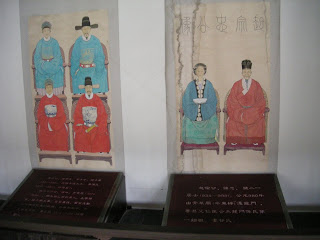 A well. These wells are still being used.
A well. These wells are still being used. An old alleyway
An old alleyway In a museum
In a museum Old building
Old buildingand bridges made of small rounded stones.
 Old building at entrance made of rounded stones.
Old building at entrance made of rounded stones.We had a wonderful expedition yesterday. We were at the West Gate by 7.30 am and because there were so many of us, there was a big comfortable air conditioned bus. One of the other foreign teachers and I had spoken to the International Exchange about these trips. Usually they give us three or four days notice about these trips and many of us have made other commitments. Perhaps booked to go elsewhere, or made time to spend with students.
In any case, on this occasion, not only did we get several weeks notice, but more details about the intended route and destination. Now we can fill a big bus!
The visit was planned to go to Longmen (Dragon Wall) and Fuyang. Still in Zhejiang Province but both places having historical significance. Longmen was our first stop. This is an ancient village going back to the Ming and Qing dynasties and despite some modernization, it is clear to see the way people lived way back then. Narrow alleyways, old buildings, ancient archways, and lots more.
One thing that appealed to us was that there were few people there. We are mostly accustomed to walking with crowds of Chinese and other tourists, and it was pleasant to have few people around. Sad though, as I would imagine this place would only survive because of tourists.
The ancient village is some 10 kms from the city, and surrounded by mountains and farms. There was rice being harvested nearby - and I managed to get a few photos of this.
I have found very little information about this place on the Internet - most information about Longmen is about the Longmen Grottos another historical place in the area, but we did not see that. I found this interesting information on a blogsite. (http://www.casualacquaintance.com/)
"One familial clan dominates, the descendants of a man named Sun Quan, who was a king during the Wuyue Kingdom. Around 95% of the town's population even today bears his surname, Sun, and a line of descent parallel to that running through Longmen Village was responsible for the production of China's Republican hero, Sun Zhongshan, better known to English speakers as Sun Yatsen. One of the town's own favorite sons was Sun Kun, who isn't that interesting except for the fact that he built ships for one of the most intriguing characters in Chinese history--and my own personal favorite--Zheng He, the eunuch from Xinjiang who captained a fleet of Ming Dynasty treasure ships throughout Southeast Asia all the way to India."
I found reference to Zheng He interesting, as in material for my course last semester, he was reputed to have discovered Australia. You will see a photo models of ships that were used to travel around the world. A small musem of models of these is at Longmen.
The village is quite large and I have no doubt that we saw only a small proportion of it. People still live there - mainly older people and they still carry out their daily chores, just as their descendants had done. However, there is modernisation. They do have phones, electricity, computers, televisions and no doubt other modern appliance behind the ancient timber and stone walls.
It is often difficult to determine what is old and what is new in some places. Some of it is obvious, but others we can not be sure. The incredible stone work of Longmen - some of it must be old, but the stones of the pathways and roads, and courtyards may have been done in relatively recent times.
We came across Chinese traditonal music being played and when we followed the sound to its source found a courtyard where a performance was being held on a raised platform. The performance was near its end when we arrived and there was a small audience seated. I marvelled at the way this old entertainment area had been modelled. It does have modern lighting and amplification, but for the rest it still looks ancient.
It is a remarkable experience to visit these places and learn more of the history of China.


No comments:
Post a Comment